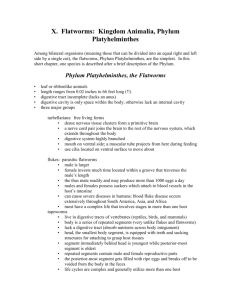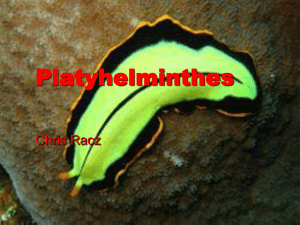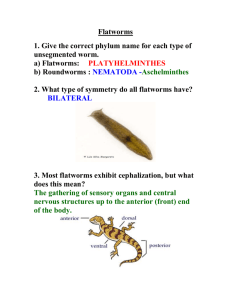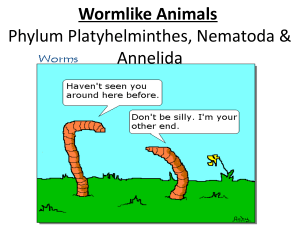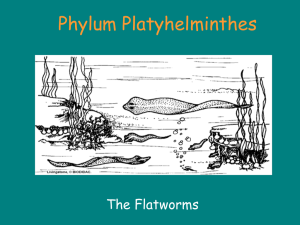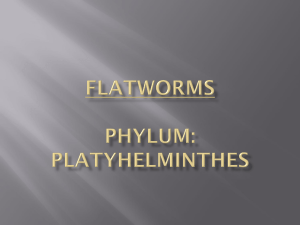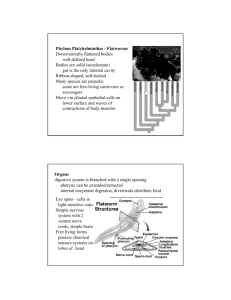INFOSHEET Terrestrial Flatworms
advertisement
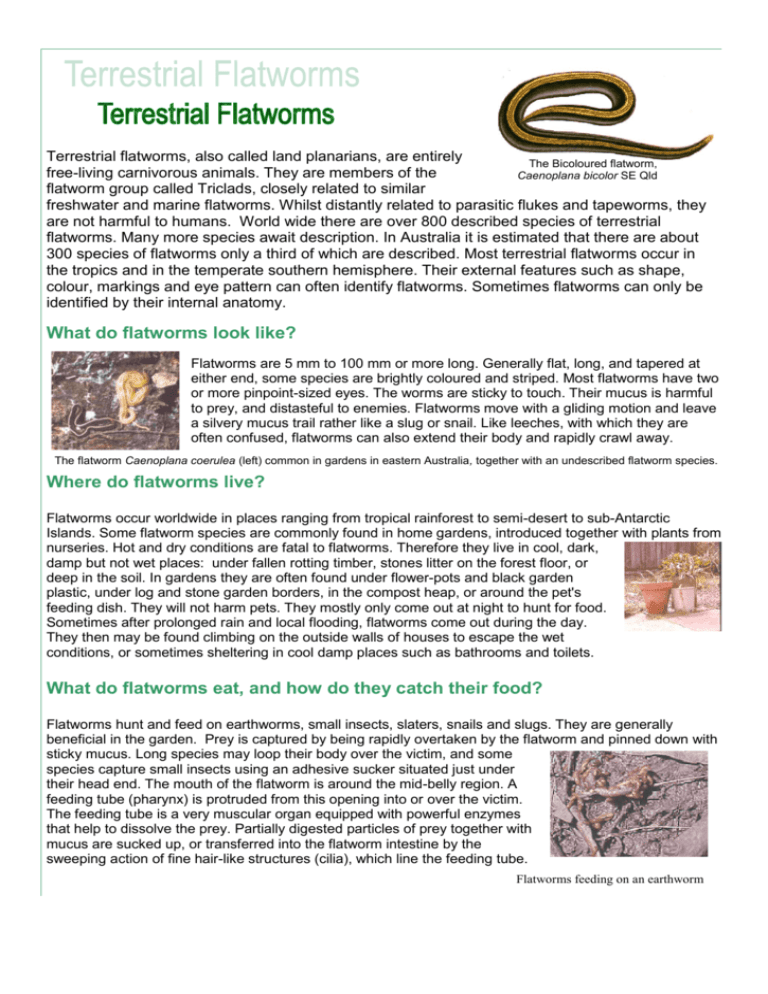
Terrestrial flatworms, also called land planarians, are entirely The Bicoloured flatworm, free-living carnivorous animals. They are members of the Caenoplana bicolor SE Qld flatworm group called Triclads, closely related to similar freshwater and marine flatworms. Whilst distantly related to parasitic flukes and tapeworms, they are not harmful to humans. World wide there are over 800 described species of terrestrial flatworms. Many more species await description. In Australia it is estimated that there are about 300 species of flatworms only a third of which are described. Most terrestrial flatworms occur in the tropics and in the temperate southern hemisphere. Their external features such as shape, colour, markings and eye pattern can often identify flatworms. Sometimes flatworms can only be identified by their internal anatomy. What do flatworms look like? Flatworms are 5 mm to 100 mm or more long. Generally flat, long, and tapered at either end, some species are brightly coloured and striped. Most flatworms have two or more pinpoint-sized eyes. The worms are sticky to touch. Their mucus is harmful to prey, and distasteful to enemies. Flatworms move with a gliding motion and leave a silvery mucus trail rather like a slug or snail. Like leeches, with which they are often confused, flatworms can also extend their body and rapidly crawl away. The flatworm Caenoplana coerulea (left) common in gardens in eastern Australia, together with an undescribed flatworm species. Where do flatworms live? Flatworms occur worldwide in places ranging from tropical rainforest to semi-desert to sub-Antarctic Islands. Some flatworm species are commonly found in home gardens, introduced together with plants from nurseries. Hot and dry conditions are fatal to flatworms. Therefore they live in cool, dark, damp but not wet places: under fallen rotting timber, stones litter on the forest floor, or deep in the soil. In gardens they are often found under flower-pots and black garden plastic, under log and stone garden borders, in the compost heap, or around the pet's feeding dish. They will not harm pets. They mostly only come out at night to hunt for food. Sometimes after prolonged rain and local flooding, flatworms come out during the day. They then may be found climbing on the outside walls of houses to escape the wet conditions, or sometimes sheltering in cool damp places such as bathrooms and toilets. What do flatworms eat, and how do they catch their food? Flatworms hunt and feed on earthworms, small insects, slaters, snails and slugs. They are generally beneficial in the garden. Prey is captured by being rapidly overtaken by the flatworm and pinned down with sticky mucus. Long species may loop their body over the victim, and some species capture small insects using an adhesive sucker situated just under their head end. The mouth of the flatworm is around the mid-belly region. A feeding tube (pharynx) is protruded from this opening into or over the victim. The feeding tube is a very muscular organ equipped with powerful enzymes that help to dissolve the prey. Partially digested particles of prey together with mucus are sucked up, or transferred into the flatworm intestine by the sweeping action of fine hair-like structures (cilia), which line the feeding tube. Flatworms feeding on an earthworm How do flatworms reproduce? Terrestrial flatworms have both male and female sex organs and are hermaphrodites. Normally they reproduce by cross-fertilization with another of their species. Embryos are protected within a tough-skinned cocoon laid by the flatworm during autumn and spring in a humid, protected site, for example cemented under a log. There may be 1-15 young in each cocoon, which hatch after 8-9 days. The young flatworms take about six to nine months to mature. Some long thin flatworms can reproduce by fragmentation. The process normally occurs 24-48 hours after the flatworm has fed. It begins with pinching 1-2 Flatworm cocoon centimetres from the hind end of the body. Eventually the hind portion of the worm catches on something, breaks off, and then crawls away. Over the next 1-2 weeks the fragment fully regenerates to form a new worm. Flatworms live for about a year. Threats to flatworms …. Terrestrial flatworms are at the top of their food chain. Few other inhabitants of their world eat the flatworms. Humans are the greatest threat to flatworms. Removal of fallen timber from land for firewood, deforestation, and land clearing destroy flatworm habitat. Frequent forest fires can burn fallen timber, destroy food sources, and may result in fewer flatworm species in that area. Under these conditions some flatworm species with special living requirements may disappear. …… and threats from flatworms Earthworm farms in Australia and overseas are sometimes plagued by species of native and introduced predator flatworms which eat the earthworms*. Introduced Australian and New Zealand flatworms have seriously reduced numbers of earthworms in parts of the United Kingdom The New Guinea flatworm and Europe, and are considered agricultural pests. Garden Centres feeding on a Giant African snail have been identified as a major factor in spreading these pests.* The New Guinea flatworm (Platydemus manokwari) is used to biologically control the Giant African snail, a serious pest in the Pacific region. However this flatworm is a conservation threat as it also eats native Pacific island snail species.* Some flatworm species in Hawaii and in New Caledonia are hosts for the Rat Lung worm, the cause of one form of encephalitis in humans. Careful washing of fresh vegetables before eating them reduces the risk of accidentally eating a flatworm and possibly being infected by the parasite. Flatworms sometimes accidentally crawl or stick onto people and pets. This may happen when you are in the garden. Although alarming, the flatworms will not harm you or your pets. Some of the more common flatworms found in gardens are illustrated below. The White flatworm, Australoplana alba. Origin: Australia The Shovel-headed flatworm, Bipalium kewense. Origin: Vietnam The New Guinea flatworm, Platydemus manokwari. Where can I obtain further information? INFOSHEETS are available with instructions on sending specimens for identification from Dr. Leigh Winsor, Adjunct Senior Research Fellow, School of Marine & Tropical Biology, James Cook University, TOWNSVILLE, Qld 4811 Phone (07) 4773 3482 Mobile 0428 735 516 Email Leigh.Winsor@my.jcu.edu.au Information provided here may be freely used elsewhere provided due acknowledgment of the source is given. ©LW V5, 05/2011


